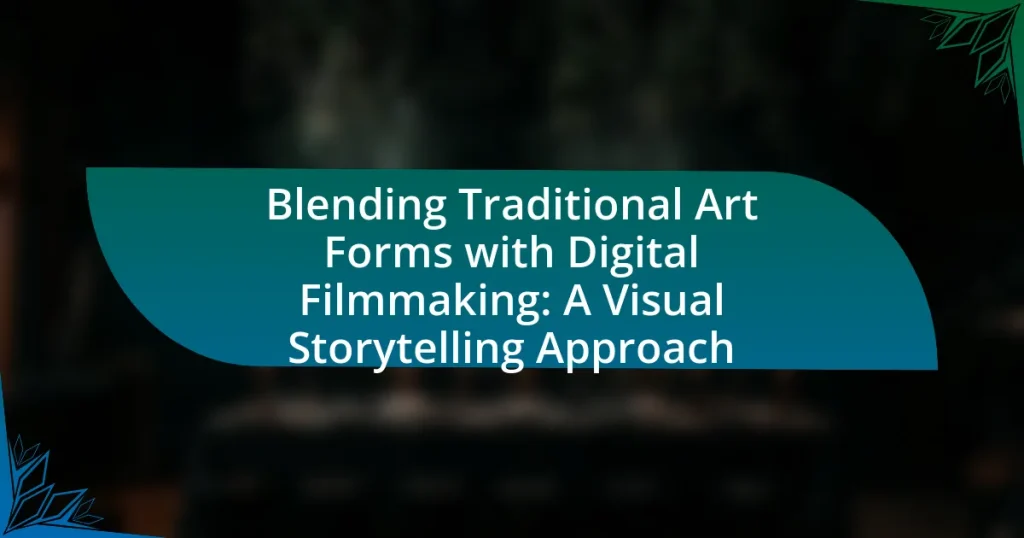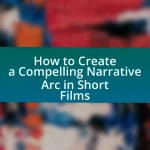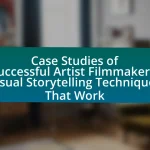Blending traditional art forms with digital filmmaking involves integrating established artistic techniques and aesthetics, such as painting, sculpture, and theater, into modern digital cinema. This fusion enhances storytelling by combining the expressive qualities of traditional media with the dynamic capabilities of digital technology, resulting in innovative visual narratives. The article explores how traditional art influences digital filmmaking, the specific art forms commonly integrated, and the importance of visual storytelling in engaging audiences. It also addresses the challenges filmmakers face in this blending process, including maintaining authenticity and avoiding cultural appropriation, while highlighting successful examples and best practices for effective integration.
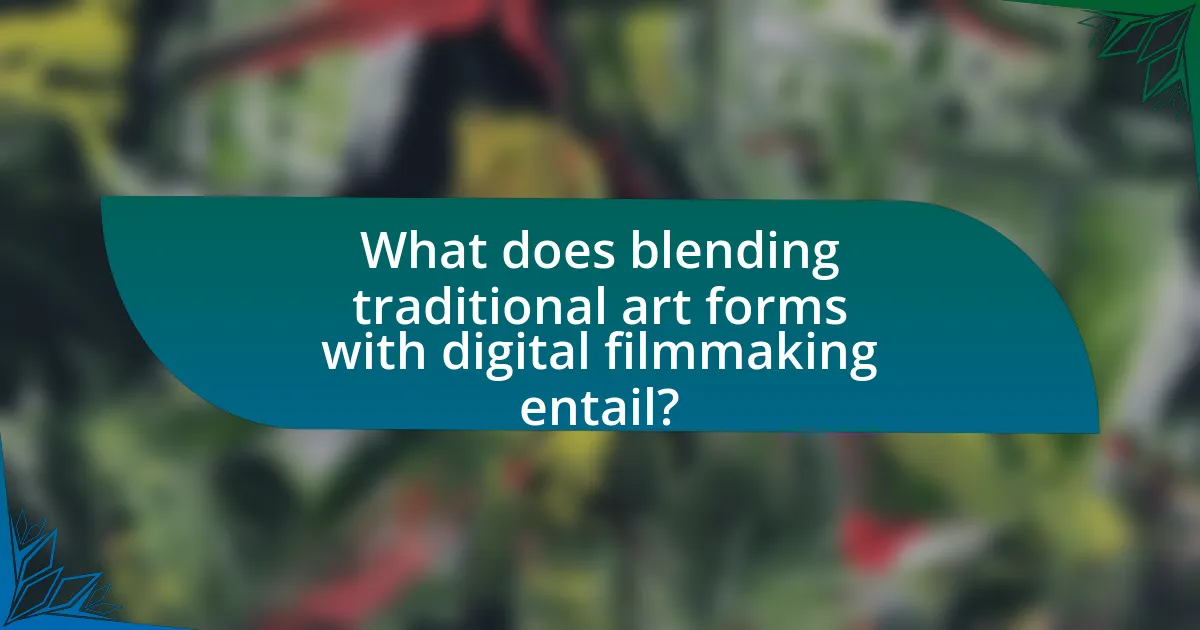
What does blending traditional art forms with digital filmmaking entail?
Blending traditional art forms with digital filmmaking entails the integration of techniques and aesthetics from established art practices, such as painting, sculpture, and theater, into the realm of modern digital cinema. This fusion enhances storytelling by combining the tactile, expressive qualities of traditional media with the dynamic capabilities of digital technology, allowing for innovative visual narratives. For instance, the use of hand-drawn animation alongside CGI can create a unique visual style that pays homage to classic animation while utilizing contemporary tools. This approach has been exemplified in films like “The Secret of Kells,” which merges traditional Irish art with digital animation techniques, demonstrating how such blending can enrich the viewer’s experience and expand the possibilities of visual storytelling.
How do traditional art forms influence digital filmmaking?
Traditional art forms significantly influence digital filmmaking by providing foundational techniques, aesthetic principles, and narrative structures that enhance visual storytelling. For instance, techniques from painting, such as composition and color theory, inform cinematography and set design in films, allowing filmmakers to create visually compelling scenes. Additionally, narrative elements from traditional storytelling, including folklore and mythology, shape character development and plot arcs in digital narratives. Historical examples include the use of chiaroscuro from Renaissance painting in film lighting and the adaptation of classic literature into screenplays, demonstrating the enduring impact of traditional art on contemporary filmmaking practices.
What specific traditional art forms are commonly integrated into digital filmmaking?
Specific traditional art forms commonly integrated into digital filmmaking include painting, sculpture, dance, theater, and photography. These art forms enhance visual storytelling by providing rich aesthetic elements and cultural context. For instance, painting techniques can influence color grading and composition in film, while dance choreography can be choreographed and captured using digital tools to create dynamic movement on screen. Additionally, theater traditions contribute to character development and narrative structure, and photography informs cinematography through framing and lighting techniques. The integration of these traditional art forms into digital filmmaking enriches the overall cinematic experience, making it more engaging and visually compelling.
How does the integration of these art forms enhance visual storytelling?
The integration of traditional art forms with digital filmmaking enhances visual storytelling by creating a richer, multi-layered narrative experience. This blending allows filmmakers to incorporate diverse artistic techniques, such as painting, sculpture, and performance art, which can evoke deeper emotional responses and provide unique visual aesthetics. For instance, the use of hand-drawn animation alongside live-action footage can create a surreal atmosphere that captivates audiences, as seen in films like “Who Framed Roger Rabbit,” where the combination of animation and real-world settings effectively tells a complex story. This approach not only broadens the visual palette but also engages viewers on multiple sensory levels, making the storytelling more immersive and impactful.
Why is visual storytelling important in filmmaking?
Visual storytelling is important in filmmaking because it effectively conveys emotions and narratives through imagery, enhancing audience engagement. This method allows filmmakers to communicate complex ideas and themes without relying solely on dialogue, making the story more accessible and impactful. Research indicates that visual elements can evoke emotional responses more powerfully than words alone, as demonstrated in studies showing that visuals can increase retention of information by up to 65%. Therefore, integrating visual storytelling techniques is essential for creating compelling and memorable films.
What role does visual storytelling play in audience engagement?
Visual storytelling significantly enhances audience engagement by creating an emotional connection through compelling imagery and narrative. This method allows audiences to process information more effectively, as studies show that visuals are processed 60,000 times faster than text. Furthermore, engaging visuals can evoke emotions, making the content more memorable; for instance, research indicates that people remember 80% of what they see and do, compared to only 20% of what they read. By integrating traditional art forms with digital filmmaking, visual storytelling captures attention and fosters a deeper understanding of the narrative, ultimately leading to increased audience retention and interaction.
How can blending art forms create a unique narrative experience?
Blending art forms creates a unique narrative experience by integrating diverse mediums, which enhances storytelling depth and emotional resonance. For instance, combining visual arts like painting or sculpture with digital filmmaking allows for a richer visual palette, engaging audiences through multiple sensory channels. This approach has been exemplified in works such as “The Lion King” musical, where traditional African art influences are merged with modern theatrical techniques, resulting in a compelling narrative that resonates across cultures. Such integration not only broadens the narrative scope but also invites audiences to interpret stories through varied artistic lenses, fostering a more immersive experience.
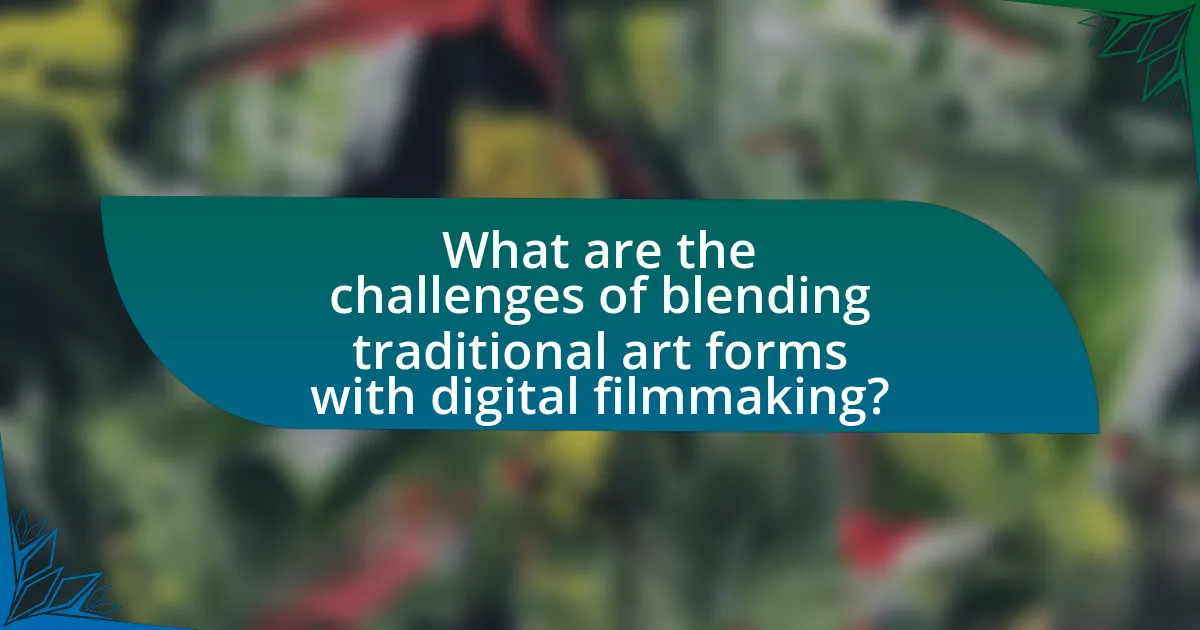
What are the challenges of blending traditional art forms with digital filmmaking?
Blending traditional art forms with digital filmmaking presents several challenges, primarily including the preservation of artistic integrity, the integration of differing techniques, and the potential for audience disconnect. Artistic integrity can be compromised when traditional methods are altered to fit digital formats, leading to a loss of authenticity. Additionally, integrating techniques from diverse art forms, such as painting or sculpture, into a cohesive digital narrative can be technically complex and may require specialized skills that not all filmmakers possess. Furthermore, audiences accustomed to either traditional or digital mediums may struggle to appreciate the hybrid approach, resulting in a disconnect that can affect the overall reception of the work.
How can filmmakers overcome these challenges?
Filmmakers can overcome challenges in blending traditional art forms with digital filmmaking by integrating collaborative techniques that leverage both mediums effectively. For instance, they can engage traditional artists in the pre-production phase to ensure that their artistic vision aligns with digital capabilities, fostering a seamless integration of styles. Additionally, filmmakers can utilize advanced technology, such as augmented reality and virtual reality, to enhance traditional art forms, making them more accessible and engaging for modern audiences. Research indicates that projects combining traditional and digital techniques, like the animated film “The Breadwinner,” have successfully attracted diverse audiences and received critical acclaim, demonstrating the potential of this approach.
What technical skills are necessary for successful integration?
Successful integration of traditional art forms with digital filmmaking requires technical skills in digital editing software, animation techniques, and sound design. Proficiency in software such as Adobe Premiere Pro or Final Cut Pro is essential for editing video content, while knowledge of animation tools like Adobe After Effects enables the incorporation of animated elements. Additionally, understanding sound design principles and software like Pro Tools or Audacity is crucial for creating a cohesive audio-visual experience. These skills collectively facilitate the seamless blending of various artistic mediums, enhancing the overall storytelling approach in digital filmmaking.
How can collaboration between artists and filmmakers enhance the process?
Collaboration between artists and filmmakers enhances the process by integrating diverse creative perspectives, which leads to richer visual storytelling. When artists contribute their unique styles and techniques, they can influence the aesthetic and emotional depth of a film, resulting in a more engaging viewer experience. For instance, the collaboration between painter David Hockney and filmmaker Peter Greenaway in the 1980s showcased how traditional art could inform cinematic composition and narrative structure, ultimately creating a more immersive storytelling environment. This synergy not only broadens the artistic scope but also fosters innovation, as seen in projects like “Loving Vincent,” where traditional painting techniques were used to animate a film, merging art and cinema in a groundbreaking way.
What are the potential pitfalls in this blending process?
The potential pitfalls in blending traditional art forms with digital filmmaking include loss of authenticity, technical challenges, and audience disconnect. Loss of authenticity occurs when traditional techniques are overly modified or simplified for digital formats, potentially alienating purists who value the original art form. Technical challenges arise from the integration of different mediums, which may require specialized skills and tools that not all artists possess, leading to inconsistent quality. Audience disconnect can happen if the fusion of styles does not resonate with viewers, resulting in confusion or a lack of engagement with the narrative. These pitfalls highlight the need for careful consideration and balance in the blending process to maintain the integrity of both art forms.
How can filmmakers avoid cultural appropriation when using traditional art forms?
Filmmakers can avoid cultural appropriation when using traditional art forms by engaging in thorough research and collaboration with the originating communities. This approach ensures that filmmakers understand the cultural significance and context of the art forms they wish to incorporate. For instance, consulting with cultural experts or artists from the community can provide insights that prevent misrepresentation and exploitation. Additionally, obtaining permission and crediting the original creators fosters respect and acknowledges the source of inspiration. This practice aligns with ethical filmmaking standards and promotes cultural sensitivity, as seen in projects like Disney’s “Moana,” which involved consultation with Pacific Islander communities to authentically represent their culture.
What are the risks of losing authenticity in the storytelling process?
Losing authenticity in the storytelling process risks alienating the audience and diluting the narrative’s emotional impact. When stories become overly commercialized or manipulated to fit trends, they often fail to resonate with viewers who seek genuine connections. Research indicates that audiences are more likely to engage with narratives that reflect real experiences and emotions, as highlighted in a study by the University of Southern California, which found that authentic storytelling enhances viewer empathy and retention. Additionally, the erosion of authenticity can lead to cultural appropriation, where traditional narratives are misrepresented or exploited, further distancing the original context and meaning from the audience.

What are some successful examples of this blending in practice?
Successful examples of blending traditional art forms with digital filmmaking include the animated film “The Breadwinner,” which combines hand-drawn animation with digital techniques to tell a culturally rich story rooted in Afghan traditions. Another notable example is “Loving Vincent,” the first fully painted feature film, where each frame is an oil painting inspired by Vincent van Gogh’s style, merging classical art with modern animation technology. Additionally, the short film “The Lost Thing,” which utilizes a mix of stop-motion and digital animation, showcases how traditional craftsmanship can enhance contemporary storytelling. These examples demonstrate the effective integration of traditional art methods with digital filmmaking, resulting in innovative visual narratives.
How have filmmakers effectively combined traditional art with digital techniques?
Filmmakers have effectively combined traditional art with digital techniques by integrating hand-drawn animation, painting, and sculpture into digital environments and visual effects. For instance, the film “Spider-Man: Into the Spider-Verse” utilized a unique blend of hand-drawn comic book aesthetics with 3D animation, creating a visually striking experience that honors traditional comic art while leveraging modern technology. This approach not only enhances the storytelling but also pays homage to the roots of visual art, demonstrating how traditional methods can coexist and enrich digital filmmaking.
What specific films or projects exemplify this approach?
“Blending Traditional Art Forms with Digital Filmmaking: A Visual Storytelling Approach” is exemplified by films such as “The Tale of the Princess Kaguya” and “Loving Vincent.” “The Tale of the Princess Kaguya,” directed by Isao Takahata, utilizes hand-drawn animation inspired by Japanese watercolor painting, merging traditional art techniques with modern storytelling. “Loving Vincent,” directed by Dorota Kobiela and Hugh Welchman, employs oil painting techniques to create a unique animated film that pays homage to Vincent van Gogh’s artwork, showcasing how traditional art can enhance digital filmmaking. Both projects illustrate the successful integration of classic artistic methods into contemporary cinematic practices.
What lessons can be learned from these successful examples?
Successful examples of blending traditional art forms with digital filmmaking demonstrate the importance of innovation and cultural preservation. These cases highlight that integrating traditional techniques with modern technology can enhance storytelling and engage diverse audiences. For instance, the use of hand-drawn animation combined with digital effects in films like “The Secret of Kells” showcases how traditional artistry can enrich visual narratives while appealing to contemporary viewers. This approach not only preserves cultural heritage but also fosters creativity and collaboration across artistic disciplines, as seen in projects that involve artists from various backgrounds working together to create unique visual experiences.
What techniques can be employed to blend these art forms effectively?
Techniques to blend traditional art forms with digital filmmaking effectively include the use of mixed media, animation integration, and collaborative storytelling. Mixed media allows artists to combine physical art elements, such as painting or sculpture, with digital components, creating a cohesive visual narrative. Animation integration involves animating traditional artworks, which can enhance storytelling by adding movement and depth, as seen in films like “The Secret of Kells,” where hand-drawn animation complements the narrative. Collaborative storytelling encourages artists from various disciplines to work together, merging their unique styles and techniques, which can lead to innovative outcomes, as demonstrated in projects like “The Lion King” Broadway adaptation, where traditional African art influences were blended with modern theatrical techniques.
How can animation and traditional painting coexist in a film?
Animation and traditional painting can coexist in a film by integrating both mediums to enhance storytelling and visual aesthetics. This integration allows filmmakers to create a unique visual style that combines the fluidity and dynamism of animation with the texture and depth of traditional painting. For instance, films like “The Triplets of Belleville” and “Loving Vincent” showcase how animated sequences can be layered over painted backgrounds, creating a harmonious blend that enriches the narrative. This approach not only preserves the artistic qualities of traditional painting but also leverages the versatility of animation to convey emotions and movement effectively.
What role does sound design play in enhancing visual storytelling?
Sound design plays a crucial role in enhancing visual storytelling by creating an immersive auditory experience that complements and amplifies the visual elements. It establishes mood, conveys emotions, and provides context, thereby enriching the narrative. For instance, a study by the University of Southern California found that sound design significantly influences audience perception and emotional engagement, with 70% of viewers reporting a stronger connection to the story when sound elements were effectively integrated. This demonstrates that sound design is not merely an accessory but an integral component that shapes the overall storytelling experience in digital filmmaking.
What best practices should filmmakers follow when blending traditional art forms with digital filmmaking?
Filmmakers should prioritize collaboration between traditional artists and digital teams to effectively blend traditional art forms with digital filmmaking. This collaboration ensures that the unique qualities of traditional art are preserved while leveraging digital technology for enhanced storytelling. For instance, integrating hand-drawn animation with CGI can create a visually rich narrative, as seen in films like “The Lion King” (1994) which combined traditional animation techniques with digital enhancements. Additionally, filmmakers should maintain a clear vision that respects the integrity of traditional art forms, ensuring that digital elements complement rather than overshadow them. This approach is supported by the success of projects like “Spider-Man: Into the Spider-Verse,” which utilized a hybrid animation style to honor comic book aesthetics while employing modern digital techniques.
